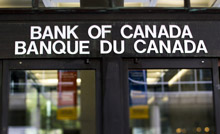
The Bank of Canada stuck with its key lending rate Wednesday, a move that essentially hands over the economy-boosting controls to the federal government.
Governor Stephen Poloz offered a peek behind the scenes, saying senior bank officials entered pre-announcement deliberations with a bias toward making another cut to the already-low interest rate of 0.5%.
The goal was to provide more help to the struggling economy.
But their eventual decision to stand pat, Poloz recalled, came after mulling over what he considers an important factor: Ottawa’s promise to pump billions into infrastructure projects.
The central bank also justified holding the rate because the key indicator in its decision — inflation — has been unfolding as expected within its ideal target range.
But the rate decision suggests the bank could stay on the sidelines while it waits for the Liberal government’s spending package.
Details of the government’s infrastructure projects may have to wait until the spring federal budget, expected in March.
Questions remain whether the federal stimulus plan will be adequate — and deployed quickly enough.
Poloz declined to speculate on those questions because the scope and timing of the program remains unknown. As a result, the Bank of Canada left out the potential positive impacts of any fiscal measures in its fresh forecasts released Wednesday.
For now, the central bank has lowered its 2016 economic growth projection — as measured by real gross domestic product — to 1.4%, down from its fall prediction of 2%.
But any fiscal measures, Poloz says, would likely help the stubbornly sluggish economy, which he believes suffered a “significant setback” mostly due to falling commodity prices.
That means the bank’s 2016 real GDP forecast could still receive a bump.
“Yes, you should treat it as an asterisk,” Poloz told a news conference when asked whether the projection could change once the federal infrastructure plan is announced.
“The direction is clear. The government says that it will do something.”
The bank’s latest monetary policy report, also released Wednesday, said Ottawa’s spending promises represent “an important upside risk to the outlook” and could “generate broader spillovers to the economy.”
The original Liberal plan was to invest $60 billion in infrastructure over 10 years, with $17.4 billion set to flow during the first mandate — an initiative the party says will create deficits over the coming years.
Insiders recently told The Canadian Press the government is actively considering expediting the infrastructure spending, which the Liberals have repeatedly said will kick-start growth and create jobs.
It’s a different scenario than last year, when the previous Conservative government strove to produce a balanced budget rather than run a shortfall to provide stimulus.
With no fiscal help from the Tories as oil prices tumbled, Poloz dropped the bank’s trendsetting rate twice last year to bring it to 0.5%. The goal was to help limit the negative economic impact of the oil-price slump.
Poloz said Wednesday that the benefits of those rate cuts are still working their way through the system.
Looking forward, the bank expects the economy to eventually rebound and see growth of 2.4% in 2017.
Until then, the country continues to adjust to what the bank describes as a complex mix of sliding resource prices, a falling Canadian dollar and weaker business investment.
For the final three months of 2015, the Bank of Canada said the economy likely stalled. It lowered its growth forecast to 0.3% for the quarter, down from its October estimate of 0.7%.
The bank said the global price of oil has dropped by more than US$20 per barrel since its October monetary policy report — putting prices about 75% lower than their peak in June 2014.
However, when it comes to translating to cheaper prices at the pump, the bank said the cost of gasoline has not fallen “as much as the reduction in crude oil prices would suggest, based on historical experience.”
The monetary policy report also suggested that increasingly low crude prices are poised to push oil producers beyond the break-even point. If a significant number of firms are affected, the bank said it could pose a potential threat to the broader economy.
Even at oil priced between US$40 and US$50 per barrel, the bank said many energy executives consider the “current composition of the industry as unsustainable.”
On Wednesday, oil was trading around the US$28 mark.
Lower oil prices have also contributed to the dollar’s nosedive.
While the weaker loonie has some negative effects, such as inflating prices on some consumer products and the cost of travel to the U.S., experts say it provides benefits for the overall economy.
The bank’s next rate announcement is scheduled for March 9.